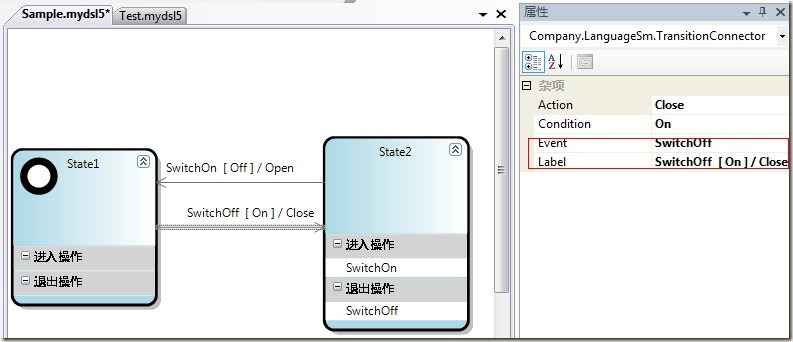上一節我們在設計器的顯示方面進行了完善,在這一節,我們將深入狀態機設計器的一些邏輯細節,給我 們的設計器添加邏輯規則.為生成代碼做好准備.
在開始之前,我們先看一下Transition的幾個屬性之間的關系:
1.編輯Event,Condition,Action屬性時,Label屬性能夠自動計算顯示,計算邏輯為Event [Condition] / Action
2.當修改屬性Label時,Event,Condition,Action的值也能夠對應自動更新.
我們使用Vs.net Dsl的規則來實現:
1.在Dsl項目下新增CustomCode文件夾來存放我們的自定義的代碼,這是Dsl開發中的通用做法,Dsl再強 大也不可能不一點代碼不用寫就能夠使滿足需求,一般情況下,無論是在開發Dsl還是在使用Dsl時,都需要 結合生成的代碼和自定義代碼.在CustomCode文件夾下面新建文件夾 Validation,用於存放手寫的自定義 驗證類.
2.在Validation文件夾下面添加類TransitionLabelRule.
3.修改TransitionLabelRule繼承於ChangeRule,並使用RuleOn屬性標簽標識此規則應用到域關系 Transition上面.
using Microsoft.VisualStudio.Modeling;
namespace Company.LanguageSm
{
[RuleOn(typeof(Transition))]
public sealed class TransitionLabelRule : ChangeRule
{
}
}
4.在規則類裡面,我們需要實現ChangeRule唯一的一個方法 ElementPropertyChanged (ElementPropertyChangedEventArgs e),從這個方法我們可以看出,當Transition的一些屬性發生變化時 就會觸發這個規則,參數類型 ElementPropertyChangedEventArgs,這個參數包含當前的模型元素 ModelElement,編輯的屬性 DomainProperty,原值OldValue,新值NewValue,我們只需要判斷當前的屬性,如 果是以上的 Event,Condition,Action,Lable時,修改後就計算其余的屬性.
public override void ElementPropertyChanged(ElementPropertyChangedEventArgs e)
{
Transition t = e.ModelElement as Transition;
// Compute Label when Event changes
if (e.DomainProperty.Id == Transition.EventDomainPropertyId)
t.Label = ComputeSummary(e.NewValue as string, t.Condition, t.Action);
// Compute Label when Condition changes
else if (e.DomainProperty.Id == Transition.ConditionDomainPropertyId)
t.Label = ComputeSummary(t.Event, e.NewValue as string, t.Action);
// Compute Label when Action changes
else if (e.DomainProperty.Id == Transition.ActionDomainPropertyId)
t.Label = ComputeSummary(t.Event, t.Condition, e.NewValue as string);
// Compute Event, Condition, Action when Label changes
else if (e.DomainProperty.Id == Transition.LabelDomainPropertyId)
ComputeProperties(e.NewValue as string, t);
}
ComputeSummary是我們的輔助方法,通過Event,Condition,Action三個值來計算Lable的 值,ComputeProperties方法是由Lable的值來分別匹配出另外三個屬性的值.最後可以直接對域類的屬性進 入賦值. 這兩個輔助方法就不在這裡列出來了,在下載代碼裡可以看到.(在這裡其實是默認提交,整個規則 事件就在一個事務中).
5.重新運行項目,會發現,寫的規則沒有起作用,修改Transition的屬性時,也沒有跳到 TransitionLabelRule的斷點裡面來,這是怎麼回事呢?這其實是和Vs.net dsl 的規則機制有關,我們還需 要對這個Rule進行一下注冊, 在CustomCode下面添加LanguageSmDomainModel(GeneratedCode下面的 DomainModel.tt生成的類) 的一個partial類,在這裡類的GetCustomDomainModelTypes方法裡,添加我們的 自定義的Rule的集合,這樣 vs.net在加載時,就會自動加載這個Rule,並添加到Rule集合中.
namespace Company.LanguageSm
{
public partial class LanguageSmDomainModel
{
protected override Type[] GetCustomDomainModelTypes()
{
return new Type[]{typeof(TransitionLabelRule),};
}
}
}
6.生成轉換所有模板,我們來測試一下我們的規則:

本文配套源碼
出處:http://lonely7345.cnblogs.com/